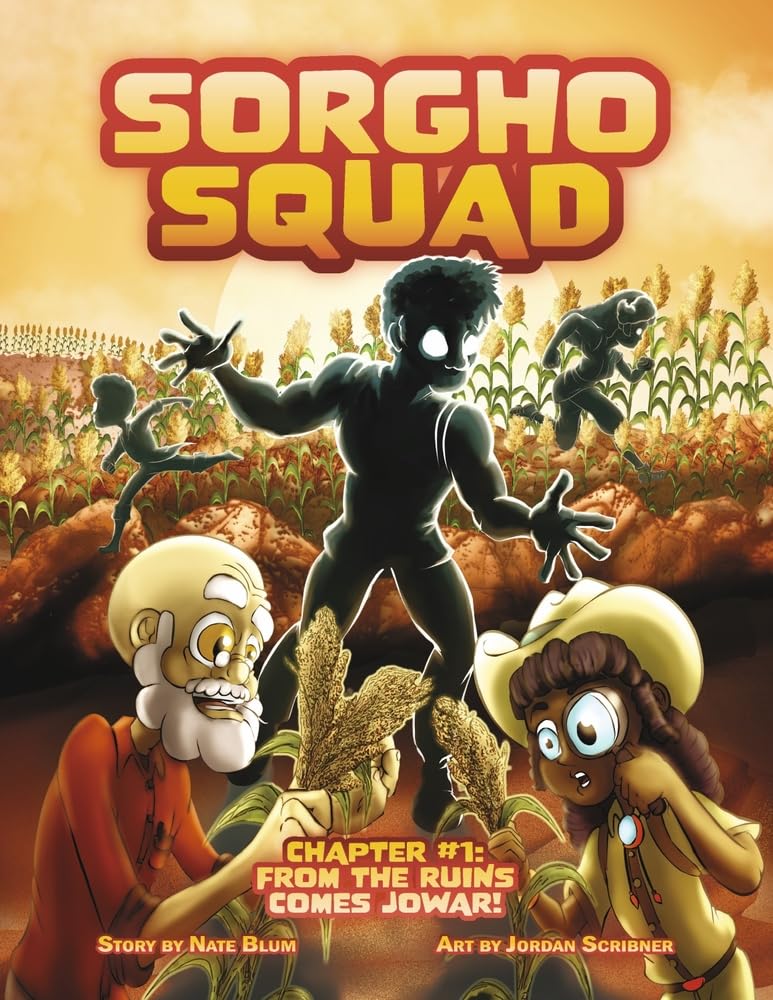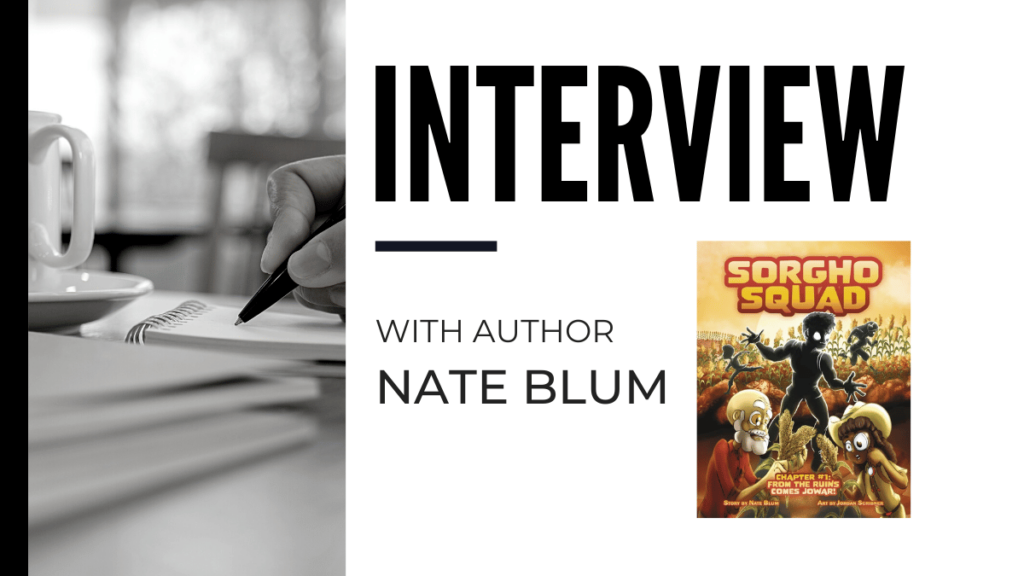An interview about The Sorgho Squad: From the Ruins Comes Jowar!, presented in partnership* with Sorghum United and The Children’s Book Review.
In this exclusive interview, we delve into the inspiration behind the captivating world of The Sorgho Squad with Nate Blum, the series creator and founder of Sorghum United, the global Non-Governmental Organization (NGO) focusing on food security and sustainability, including the promotion of small grains like sorghum.
Drawing inspiration from real-life superhero scientists like David Fairchild, renowned for introducing over 200,000 plant species to North America, the author shares insights into the fascinating world of sorghum and its diverse uses, from whole grain pilafs to comic book-style storytelling. We explore the research methods employed to sensitively depict third-world locations, the role of Sorghum United, and the educational value these books hold for both classrooms and homes.
With a passion for sustainability, Blum encourages readers to embrace a desire for learning, emphasizing the importance of understanding our agricultural heritage in the face of climate change and global hunger. Read on!
Tell us a little about the inspiration for Sorgho Squad: From the Ruins Comes Jowar – who are the real superhero scientists who gave you the idea for the Sorgho Squad?
Perhaps the most notable real-world influence on the book is the life of David Fairchild. Fairchild grew up in Kansas in the late 1800s and went on to become a botanist and was responsible for introducing over 200,000 plant species to North America. His remarkable journey of agricultural exploration and food systems transformation is retold in author Daniel Stone’s excellent book, ‘The Food Explorer’. I highly recommend it.
Do you use Sorghum products yourself? Which ones and why?
I do! At our house, we use whole grain sorghum in much the same way you might use rice in yours. As a pilaf or in soups, it provides the same culinary experience with a unique mouth-feel and superb nutrition. We also pop sorghum, which produces small kernels (I call them cutie pops), and roasted sorghum, which has a similar taste to corn nuts, but with an easier crunch. Roasted sorghum and cooked sorghum can also be used in salads. For baking, I use an all-purpose sorghum flour blend as a direct substitute for wheat flour. No special recipe is needed so long as the blend includes a xanthan gum binder and a bit of other starches.
The series features a lot of third-world locations – what kind of research did you have to do to depict
these locations sensitively and accurately?
I leveraged a long-time love of reading historical non-fiction. I suppose you could say that the methodology is one of long-term casual research rather than traditional research. I’ve always held a fascination with the human story, in any epoch, really. Some of my friends would say that I enjoy ‘boring’ topics. But, I personally think that when we read about our own history, we have an opportunity to learn from the mistakes and successes of others. Plus, I find that historical events are much more interesting than anything that fiction can provide.
The fact sheet at the end of the book features the Sorghum Institute – can you tell us a bit more about the Institute and its role in developing the idea for this series?
I think you may be referring to Sorghum United. Sorghum United is a global Non-Governmental Organization (NGO) that focuses on food security, malnutrition, and economic and environmental sustainability through the promotion of small grains such as sorghum and millet. I serve as the founder and CEO of the organization. Our network includes hundreds of partners at the grassroots level who represent all points in the sorghum and millet value chain. We have members on every continent except for Antarctica. The Sorgho Squad books are one revenue source for our work in promoting regional value chains using these grains, and they serve as our consumer education and outreach endeavors.
Readers can learn more about our work at: www.sorghumunited.com.
If you would like readers to learn one thing from reading this series, what would it be?
The one thing I would like readers to learn is the desire to learn more. These heritage grains, as I call them, really are a unique and forgotten part of the human story. They are among the earliest grains cultivated by mankind. And the health benefits and environmental benefits are only now being rediscovered in the modern scientific sense. It really is the beginning of a revolution in how we approach food production and consumption while promoting sustainable industrial materials and maintaining biodiversity. I grew up on a farm in Nebraska, and I’ve been working in agriculture policy and advocacy directly for over a decade. I’ve never had more fun in this work than I am having right now.
The comic-book-style artwork really adds to the adventure and superhero theme. What made you choose this approach instead of a traditional non-fiction book style?
First of all, I am a huge comic book nerd. The Amazing Spider-Man specifically. Over thirty-one years of collecting, I have amassed a complete run of the series from 1962 to the present. So, the medium is one that I hold dear. A great American art and storytelling form, really. Since the genre captivated my fascination as a child, it made sense that we would present these books in the same format. Doing so allows us to make real-world issues, some of the most complex systemic challenges around sustainability, by the way, to be broken down in a way that is easily understandable and digestible for younger readers.
How do you think parents and educators can use this book? What do you imagine when you picture it used in a classroom or home setting?
When I first showed “Chapter #1: From the Ruins Comes Jowar…” to my fifteen-year-old daughter, she told me that it was good. But, it reminded her of something her science teacher would assign as reading. I took this as a compliment. We’ve seen that these books touch on curricular goals around science, multiculturalism, and health. Kids do enjoy reading them, and we’re seeing teachers begin to enjoy assigning them in the classroom. They provide a fun educational activity that can then elicit many more in-depth dialogues in the classroom.
What advice do you have for readers who feel anxious or overwhelmed by issues like climate change and global hunger?
I would first advise you to take a deep breath. The world isn’t at stake. Only our place as a species upon it. Remember that our planet has undergone many climatological changes over the course of its 4.5 billion-year journey around the Milky Way. That said, our climate crisis wasn’t caused in a generation. It won’t be solved in a generation. All we can do is adjust to what the world is giving us while adjusting to how we interact with the world.
It will take leaders in the current and successive generations to lead that change. And we’re talking about systemic changes. These have to be done slowly in order to prevent social and economic systemic breakdowns. Yelling at one group or another while pointing a finger does more harm than good. As global citizens, we need to work together, bringing all peoples together in respectful ways, to find solutions.
What other favorite sustainability stories would you recommend to readers who have enjoyed The
Sorgho Squad?
This is a recommendation for the older readers, I suppose. But it is one that I cite frequently. Read “Collapse” by Jared Diamond. Diamond does an excellent job in that book at comparing societal responses to ecological challenges. Some adapted their cultural norms. Some did not. As you might imagine, some survived. Some did not. Diamond is one of my favorite authors, and I could only hope that he might know how much his works have influenced my thinking and my career.
Are there more sustainability-themed projects in your future after The Sorgho Squad?
Actually, Chapter 4 of the Sorgho Squad is written already. We are waiting to illustrate it and write subsequent chapters until we see how the first three are received. Considering how things are going, I imagine we might be talking about Chapters 4 through 6 at this time next year. We are also beginning to look at other mediums for the delivery of the Sorgho Squad message.
Stay tuned at www.sorghosqua.com and find us on your favorite social media platforms!
About the Book

The Sorgho Squad: From the Ruins Comes Jowar!
Written by Nate Blum
Illustrated by Jordan Scribner
Ages 7+ | 36 Pages
Publisher: BookBaby (2023) | ISBN-13: 9798350908008
Publisher’s Book Summary: Professor Sorgho and his apprentice, Alice Atlas, are faced with overwhelming challenges in our modern world. The Professor thinks he may know how to solve the global crises of food insecurity, malnutrition, sustainability, and climate change. If only he can find a legendary ancient super-team that has been lost in ancient sites around the world in time…
Buy the Book
About the Author
Nate Blum serves as the Chief Executive Officer of BlüMilo and Sorghum United. He is an expert on grain sorghum production and marketing, with a focus on value-added agriculture processing for sorghum-based products.
Blum has represented Nebraska producers on a global scale in Chile, Argentina, Uruguay, Vietnam, Germany, France, Switzerland, Italy, Jordan, Great Britain, Scotland, Australia, Japan, the United Arab Emirates, and the United Nations FAO. He has served on the Nebraska Grain Sorghum Board, the Nebraska Sorghum Producers Association, and the USDA Grains, Feed, and Oilseeds Ag Trade Advisory Committee (ATAC). He is an Alumnus of the University of Nebraska and the Nebraska Leadership, Education, Agriculture, Development (LEAD) Program. He also recently served as the vice president of the Nebraska LEAD Alumni Association.
In his free time, Blum enjoys volunteering for local non-profits and organizing community events.
For more information, visit https://www.sorghosquad.com/
This interview—Nate Blum Discusses The Sorgho Squad: From the Ruins Comes Jowar!—was conducted between Nate Blum and Dr. Jen Harrison.

